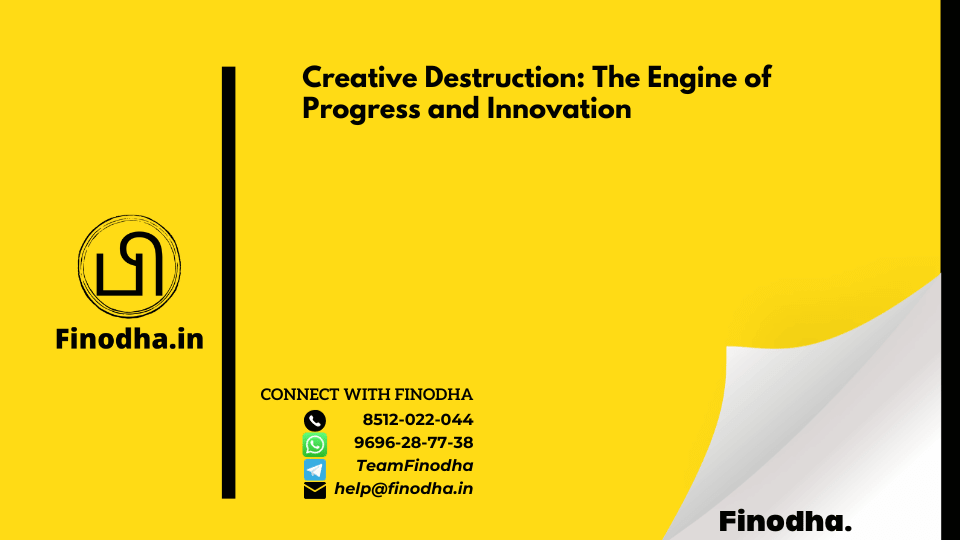Important Keywords: Creative Destruction, Joseph Schumpeter, Innovation, Economic Progress, Indian Economy, Disruption, Advantages, Disadvantages.
Table of Contents
Introduction
In the ever-evolving landscape of economics and industry, one term stands out as a driving force behind progress and innovation: Coined by the Austrian economist Joseph Schumpeter in 1942, this concept represents the dynamic process of replacing old with new, shaking up established norms, and fostering innovation. In this article, we’ll delve into the world of Creative Destruction, understand how it works, explore real-life examples, and discuss its implications in the context of the Indian economy.
The Mechanics of Creative Destruction
At its core, Creative Destruction signifies the relentless revolutionizing of the economic structure from within. It involves a perpetual cycle of replacing the old with the new, creating a dynamic environment that encourages innovation and change. Unlike traditional economic models that seek equilibrium, Creative Destruction thrives on the premise of continual transformation and growth.
This process is, as the name suggests, a combination of both creation and destruction. While it ushers in innovation, it also leads to the obsolescence of existing technologies and practices. As the business landscape evolves, new opportunities for profit emerge, making it essential for entrepreneurs and employees to adapt and reinvent themselves.
The Winners and Losers
In the world of Creative Destruction, there are inevitably winners and losers. The winners are those who embrace change, adapt to new technologies, and identify emerging opportunities. On the flip side, the losers are often those who resist change or fail to keep pace with the evolving landscape.
Take the example of Henry Ford’s assembly line, which revolutionized the automotive manufacturing industry. While it brought about unprecedented efficiency, it also displaced many skilled craftsmen. This pattern of disruptive change and the resulting shifts in employment is a hallmark of Creative Destruction.
Creative Destruction in the Digital Age: An Indian Perspective
The advent of the internet serves as a compelling example of Creative Destruction, affecting industries and job markets on a global scale. In the Indian context, this phenomenon has been particularly transformative.
Advantages
- Innovation and Progress: It is the engine of innovation. It challenges the status quo and pushes society to develop new technologies and ideas. In the Indian context, this has led to significant advancements in sectors such as information technology and biotechnology.
- Higher Living Standards: As obsolete technologies and practices are replaced, there is a natural progression towards higher living standards. New, more efficient methods of production and services lead to increased affordability and accessibility for the masses.
- Global Competitiveness: It is a driving force behind the globalization of the Indian economy. It encourages businesses to compete on a global scale, fostering economic growth and development.
Challenges and Disadvantages
- Displacement: The process of Creative Destruction can lead to job displacement, particularly in sectors heavily impacted by technological advancements. This can pose challenges for those who find themselves out of work.
- Economic Disparities: While some individuals and businesses thrive in this environment, others may struggle to adapt. This can result in economic disparities, with winners reaping substantial rewards, and losers facing hardships.
Creative Destruction in India: A Case Study
Consider the rapid growth of India’s IT industry. The advent of the internet and digital technologies led to the creation of numerous software and services companies, significantly boosting India’s global competitiveness. However, this transformation also disrupted traditional employment sectors, like administrative support and data entry. Those who adapted and acquired digital skills thrived, while others faced challenges in the evolving job market.
Conclusion
Creative Destruction is more than a theory; it’s a powerful engine that propels economies forward. In India, as in the rest of the world, it has led to remarkable progress and innovation. By understanding the dynamics of Creative Destruction, individuals and businesses can adapt and thrive in an ever-changing economic landscape. As India continues to embrace technological advancements and innovation, Creative Destruction will remain a defining force, shaping the nation’s future and driving progress.
Read More: Demystifying Ceteris Paribus: The Silent Hero of Economic Analysis
Creative Destruction: The Engine of Progress and Innovation

In the ever-evolving landscape of economics and industry, one term stands out as a driving force behind progress and innovation: Coined by the Austrian economist Joseph Schumpeter in 1942, this concept represents the dynamic process of replacing old with new, shaking up established norms, and fostering innovation.
Official Income Tax Return filing website: https://www.incometax.gov.in/iec/foportal/
Official GST common portal website: https://www.gst.gov.in/


0 Comments